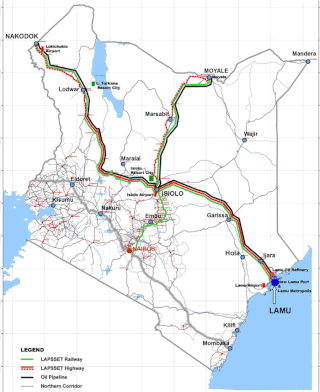
Local authorities in Kenya are the bodies controlling local governance in urban areas in Kenya.

The districts of Kenya were divided into 262 divisions (matarafa). Divisions of Kenya were further subdivided into locations. Today's counties of Kenya are based on the merging of some of the districts on this list and since the divisions are one level under the districts they are now the sub-counties. This is because Kenya recently changed its constitution and 47 Counties emerged. Here are the divisions listed below, by district :
Railway stations in Kenya include:
The Mombasa–Garissa Road, also B8 Road (Kenya) is a major highway in Kenya, the largest economy in the East African Community. The road connects the port city of Mombasa to the inland city of Garissa. This road is composed of the Mombasa–Malindi Road and the Malindi–Garissa Road.

I&M Bank Kenya Limited, is a commercial bank in Kenya, the largest economy in the East African Community. It is licensed by the Central Bank of Kenya, the central bank and national banking regulator.

Chase Bank Kenya Limited(CBK), commonly referred to as Chase Bank, was a commercial bank in Kenya, licensed by the Central Bank of Kenya, the central bank and national banking regulator.
Imperial Bank Limited commonly known as Imperial Bank, is a commercial bank in Kenya, the largest economy in the East African Community. It is one of the forty-three commercial banks licensed by the Central Bank of Kenya, the central bank and national banking regulator.
Guardian Bank, whose full name is Guardian Bank Limited, is a commercial bank in Kenya with headquarters in Nairobi. It is licensed by Central Bank of Kenya, the central bank and national banking regulator.
Gulf African Bank (GAB), whose full name is Gulf African Bank Limited, is a commercial bank in Kenya operating under an Islamic banking regime. It is licensed by the Central Bank of Kenya, the central bank and national banking regulator.
Dubai Bank Kenya (DBK), whose complete name is Dubai Bank Kenya Limited, but is often referred to as Dubai Bank, was a commercial bank in Kenya, the largest economy in the East African Community. It was licensed by the Central Bank of Kenya, the central bank and national banking regulator. The institution is not affiliated with Dubai Bank of United Arab Emirates or with that bank's parent company, Dubai Banking Group.

Lamu Port-South Sudan-Ethiopia-Transport (LAPSSET) Corridor project, also known as Lamu corridor is a transport and infrastructure project in Kenya that, when complete, will be the country's second transport corridor. Kenya's other transport corridor is the Mombasa - Uganda transport corridor that passes through Nairobi and much of the Northern Rift. Some basic LAPSSET infrastructure has been built. The construction of LAPSSET's main components is currently ongoing with construction of the first berth at Lamu Port completed in October, 2019 (situation as per October 2019).. Although the project is not formally stalled, its short to medium term success looks increasingly unlikely. Insecurity and political instability in Kenya are mostly to blame for this, as are more commercially viable alternative pipeline options through Tanzania or Ethiopia. The low oil prices since 2015 also affect LAPSSET's commercial prospects.
From late 2011 to 2014, Kenya experienced an upsurge in violent terrorist attacks. Kenyan government officials asserted that many of the murders and blasts were carried out by al-Shabaab in retaliation for Operation Linda Nchi, a coordinated military mission between the Somalian military and Kenyan military that began in October 2011, when troops from Kenya crossed the border into the conflict zones of southern Somalia. According to Kenyan security experts, the bulk of the attacks were increasingly carried out by radicalized Kenyan youth who were hired for the purpose. Kenya security officials also indicated that they were part of death squads, which carried out many of the killings under the orders of a government security council. By mid-2014, the cumulative attacks began affecting Kenya's tourism industry, as Western nations issued travel warnings to their citizens.

Sub-counties are the decentralised units through which county governments of Kenya will provide functions and services. Except for the parts which fall under urban areas, sub-counties will coincide with the constituencies created under article 89 of the Constitution of Kenya. Sub-counties will be headed by a sub-county administrator, appointed by a County Public Service Board.
The list shows flags for the forty-seven counties of Kenya. Some counties adopted the flag of the defunct municipal or district governments. Other flags adopted in the year after the first county governments were elected which was between 4 March 2013 to the same date on 2014. As of 17 December 2014, not all county assemblies have passed the design of the county flags. It is expected that all counties will adopt their own flags soon.
The Malindi–Bagamoyo Highway, also Coastline Transnational Highway, is a road in Kenya and Tanzania, connecting the cities of Malindi and Mombasa in Kenya to Tanga and Bagamoyo in Tanzania.
The Garissa–Nuno–Modogashe–Wajir Road is a road in Kenya, connecting the towns of Garissa, Nuno, Modogashe and Wajir.

Lamu-Garissa-Isiolo Road, is a road in Kenya, and is part of the Lamu-Garissa-Isiolo-Lokichar Road, which itself is a component of the Lamu Port and Lamu-Southern Sudan-Ethiopia Transport Corridor (LAPSSET) Project.

The Isiolo–Moyale Road is a road section of the A2 Road in Kenya, connecting the towns of Isiolo, Archers Post, Marsabit, and Moyale. The road is a component of the Lamu Port and Lamu-Southern Sudan-Ethiopia Transport Corridor (LAPSSET) Project. It connects Kenya to Ethiopia, its neighbor to the north.
Isiolo–Mandera Road, is a road in Kenya. It is a major transport route linking north-central Kenya to Kenya's northeast. The counties that the road traverses are generally arid, and have hitherto been undeserved. This road project is the largest and most expensive infrastructure project in northeastern Kenya since the country became independent in 1963.





